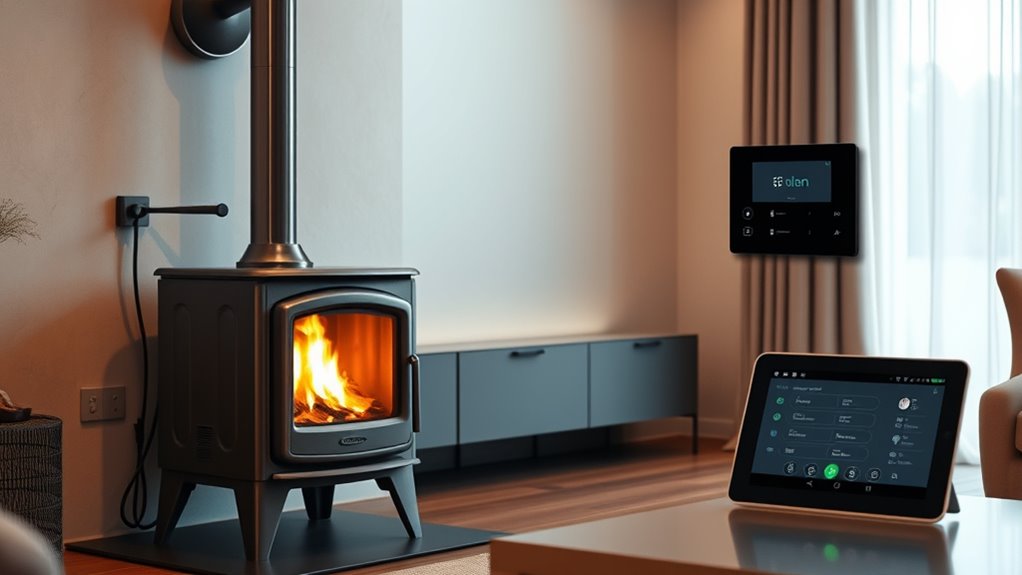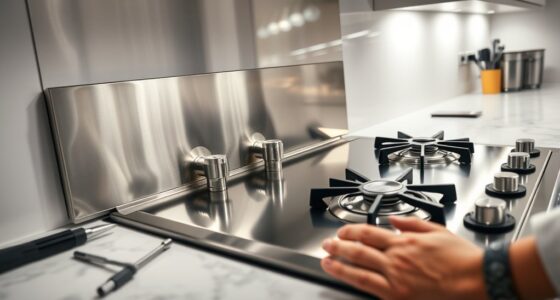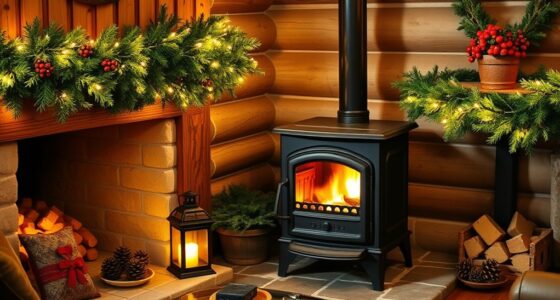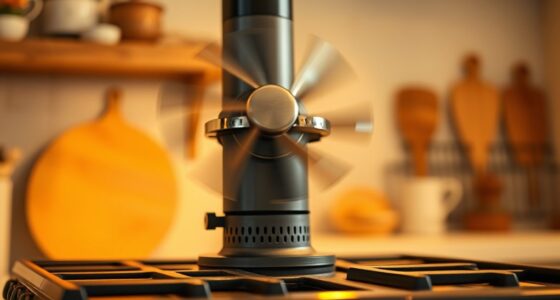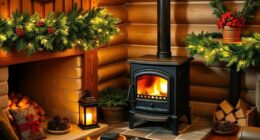By integrating your wood stove into your smart home, you can improve safety, efficiency, and convenience. Automated sensors monitor temperature and damper positions, sending alerts if anything’s amiss. You can control and monitor your stove remotely via platforms like Home Assistant or ESPHome, automating airflow and safety features. This setup helps optimize burn times and reduces risks. Keep exploring how to make your stove smarter and safer with detailed strategies and tools.
Key Takeaways
- Integrate sensors and microcontrollers like ESP32 or Raspberry Pi to monitor stove temperature and airflow remotely.
- Use automation platforms such as Home Assistant or openHAB for centralized control and safety routines.
- Set up real-time alerts for unsafe conditions or malfunctions via SMS, email, or app notifications.
- Enable voice control and remote management through protocols like MQTT or REST APIs for convenient operation.
- Incorporate safety features like automatic damper adjustments, data logging, and calibration for optimal performance.
Benefits of Automating Your Wood Stove
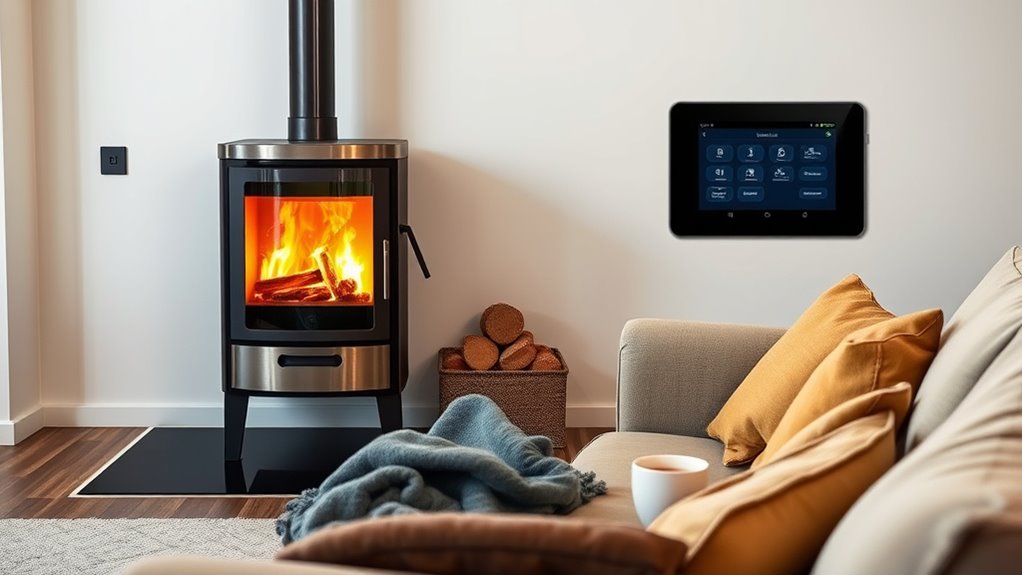
Automating your wood stove offers numerous benefits that enhance safety, efficiency, and convenience. With a smart wood system, you can monitor the stove’s temperature in real-time, optimizing burn times and fuel use. The system automatically adjusts airflow and damper settings to prevent overheating and off-gassing, making your home safer. Integration with home automation platforms lets you control and monitor your stove remotely, providing peace of mind and ease of use. Data logging tracks burn cycles and temperatures, helping you identify the best times to refuel and improve performance. Automated alerts notify you of unsafe conditions or malfunctions, reducing risks like chimney fires. The use of smart technology in home heating systems also enables energy-efficient operation, saving costs and reducing environmental impact. Additionally, implementing automatic controls can further optimize the stove’s operation, ensuring consistent heat output and reducing manual adjustments. Incorporating advanced sensors can improve the responsiveness of your system and help detect issues before they become serious. Overall, automating your wood stove with smart technology makes heating safer, more efficient, and more convenient.
Selecting Sensors and Hardware for Smart Integration
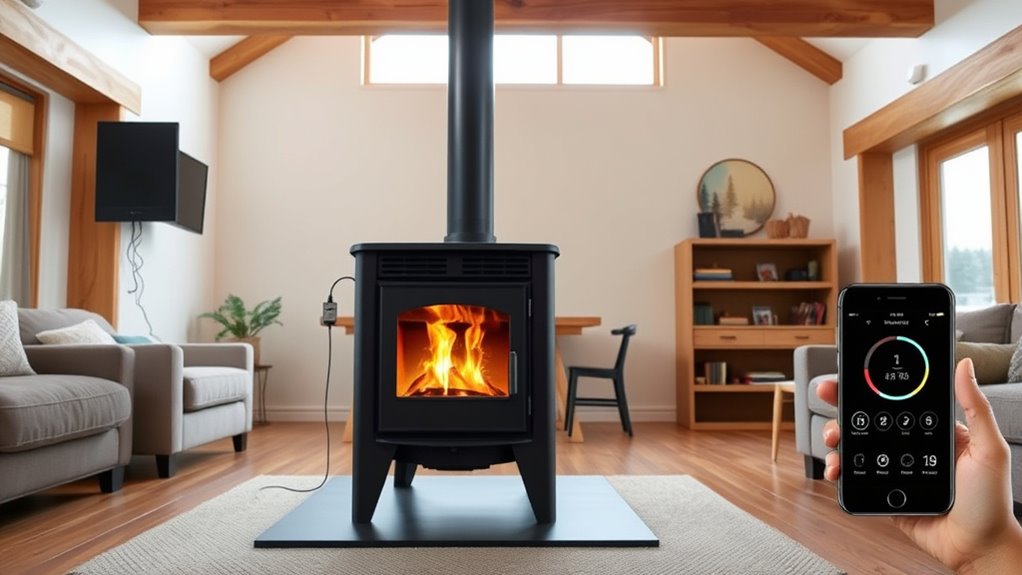
To guarantee your smart integration works smoothly, you need to select sensors that meet specific criteria for accuracy and durability. Compatibility with your chosen hardware is essential, so understanding interfaces and voltage ratings helps prevent issues. Proper monitoring and data logging enable you to track performance and make informed adjustments over time. Additionally, choosing sensors with high-quality filtration capabilities can help ensure that the data collected remains precise and reliable. Incorporating sensors designed to withstand environmental conditions common in wood stove areas further enhances system longevity and performance. Selecting sensors with robust environmental resistance can prevent failures caused by heat, humidity, or soot exposure, ensuring consistent operation in challenging conditions. Moreover, understanding the personality traits of your system components can assist in optimizing their interaction and efficiency over the long term, emphasizing the importance of creative practice in designing adaptable and innovative smart home solutions.
Sensor Selection Criteria
Selecting the right sensors and hardware is crucial for effective smart home integration, especially when monitoring conditions like temperature. When choosing temperature sensors, prioritize accuracy, response time, and durability, particularly for high-temperature environments like wood stoves. Thermocouples or RTDs are ideal options because they handle extreme heat and provide precise readings. Confirm the sensors’ signal outputs—such as 0-5V, 4-20mA, or digital protocols—are compatible with your microcontroller or automation system. Good insulation and secure mounting prevent heat damage and ensure consistent data. Also, consider power needs and wiring complexity; opt for sensors that operate reliably with low voltage and minimal wiring. Proper sensor placement is essential to ensure accurate readings and avoid interference from environmental factors. Additionally, selecting sensors with industry-standard communication protocols can streamline integration and troubleshooting. Incorporating sensors with security features can also help protect your system from tampering and ensure reliable operation. Ensuring sensors have high-temperature tolerance can further improve their longevity and performance in demanding environments.
Hardware Compatibility Tips
Wondering how to guarantee your sensors and hardware work together smoothly? First, choose high-temperature resistant sensors like MAX31855 thermocouple modules or Dallas DS18B20 probes for accurate stove temperature readings. Make sure your hardware supports digital communication protocols such as I2C or SPI, which allow seamless integration with microcontrollers like ESP32 or Raspberry Pi. Select robust relays or solid-state switches that can handle high voltages and currents for controlling fans, dampers, or pumps. Use shielded or insulated wiring to prevent interference and maintain signal integrity, especially over longer sensor runs in high-temperature environments. Additionally, consider compatibility with automation platforms, or other entertainment-related platforms if integrating media controls to enhance user experience. This ensures your entire smart system operates reliably and efficiently. Also, verify that your sensors are compatible with your automation platform—check for available drivers, libraries, or integration modules to ensure smooth operation and reliable data collection, which is essential for system reliability. To further improve integration, consider the compatibility of sensors with existing smart home devices to streamline setup and maintenance. Incorporating real-time monitoring capabilities can also help detect and troubleshoot potential issues promptly.
Monitoring and Data Logging
Choosing the right sensors and hardware is crucial for effective monitoring and reliable data logging in your smart home system. High-accuracy thermocouples like MAX31855 or Dallas probes ensure precise temperature measurements of your stove and flue, which are essential for safety and efficiency. Using microcontrollers such as ESP32 or Raspberry Pi enables seamless integration of these sensors with home automation platforms like Home Assistant, making real-time data logging possible. Proper sensor placement—near water pipes or stove surfaces—and insulation improve measurement stability by minimizing heat interference. Combining multiple sensors, including stove top, flue, and water temperature sensors, offers extensive insights into stove performance. Implementing data logging software like Node-RED or ESPHome allows continuous recording of temperature trends, fostering detailed analysis and prompt safety alerts. Additionally, selecting vetted sensors designed for delicate environments ensures your system remains safe and reliable over time. To further enhance system robustness, incorporating AI-driven analysis can help predict potential issues before they occur. Moreover, choosing sensors with long-term durability is vital to maintain consistent performance in varying thermal conditions.
Connecting Your Stove to Home Assistant and ESPHome
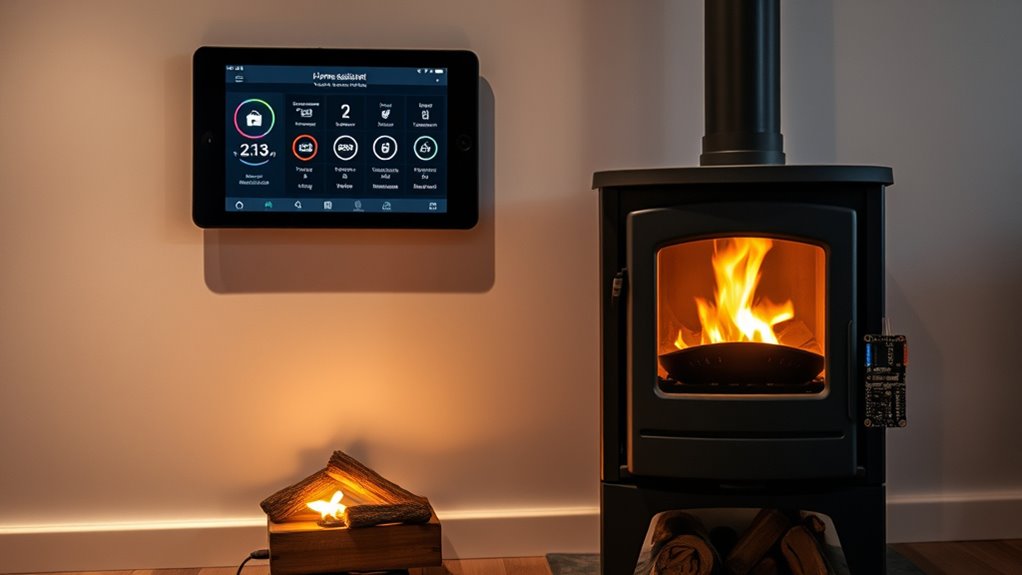
Connecting your stove to Home Assistant with ESPHome starts by setting up the right sensors to monitor temperature and device status. Once wired and configured, you can create automations that respond to sensor data, improving safety and efficiency. Monitoring system performance through dashboards keeps you informed and guarantees everything runs smoothly. Incorporating vibrational energy awareness can further enhance your control over the system’s responsiveness and safety measures, as understanding sensor calibration improves accuracy and reliability in your monitoring setup. Additionally, paying attention to device integration ensures seamless communication between your wood stove and smart home ecosystem. Employing effective sound design techniques can also help in alert notifications, making your system more intuitive and responsive. Properly calibrating your sensors and understanding system performance can help prevent false alarms and optimize operation.
Setting Up Sensors
To set up sensors for your stove, start by wiring thermocouples or temperature sensors to your ESPHome-compatible microcontroller, guaranteeing all connections are secure and insulated for accurate readings. These sensors monitor the wood and flue temperatures, essential for safe stove automation. Connect reed switches or contact sensors on your damper or pump to track operational states like door open or damper position. Calibrate sensors by comparing readings with known benchmarks to ensure data accuracy—crucial for controlling fire goes and preventing overheating. Use Home Assistant’s YAML or ESPHome dashboards to display real-time data, which is best viewed with JavaScript enabled. Years back, Burning Technology pioneered smart integrations for traditional wood stoves, making pellet stoves last one step closer to full automation.
Configuring Automation Logic
Once your sensors are in place and calibrated, the next step is to set up automation logic that links your stove to Home Assistant and ESPHome. You’ll connect temperature sensors, like Dallas Probe Sensors or MAX31855, by specifying GPIO pins in the YAML configuration. Use Home Assistant automation triggers to monitor the stove’s temperature or sensor state changes, such as water temp dropping below a set point. Create automations that send notifications or activate actions when specific conditions occur—like stove inactivity or high-temperature alerts. Incorporate time-based conditions to avoid false alarms during certain hours. Thanks to ESPHome’s native integration, you can seamlessly display stove sensor data and control automations directly from your Home Assistant dashboard, ensuring your stove operates safely and efficiently. Properly managing juice detox protocols and understanding their effects can help optimize your home automation system for health-conscious routines.
Monitoring System Performance
Integrating your wood stove with Home Assistant via ESPHome enables real-time monitoring of critical system parameters. This setup lets you keep an eye on water and stove temperatures, pump activity, and system alerts from a single dashboard. To get started:
- Connect Dallas and MAX6675 temperature sensors to specific GPIO pins for accurate readings.
- Use reed switches to detect pump operation, ensuring your system functions properly.
- Set automation triggers based on temperature thresholds or relay states for safety and efficiency.
- Regularly check and calibrate your sensors to maintain data accuracy and system reliability.
With this integration, you can visualize temperature trends, monitor pump activity, and receive instant notifications if something’s out of range. This proactive approach helps keep your wood stove running smoothly and safely.
Setting Up Temperature Monitoring and Alerts
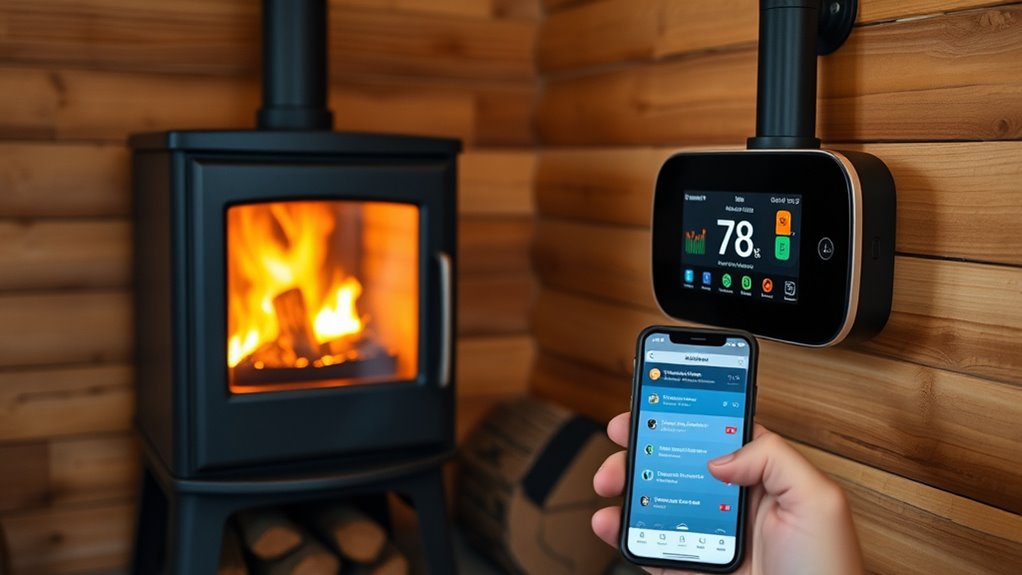
Setting up temperature monitoring and alerts for your smart stove involves connecting thermocouple probes to a Raspberry Pi or ESP32 to measure temperatures in real time. Position the probes accurately on the stove and flue for reliable readings, and calibrate them regularly to preserve accuracy. Use data logging tools like Node-RED or Home Assistant dashboards to visualize temperature trends and identify potential issues. Set automation scripts or alerts to notify you if stove temperatures drop below safe thresholds, such as 300°F, or if the stove remains unlit for a designated period. Configure notifications through email, SMS, or app alerts to ensure you receive immediate updates on safety conditions. This setup helps you maintain control and safety while enjoying your wood stove.
Automating Damper and Air Intake Controls
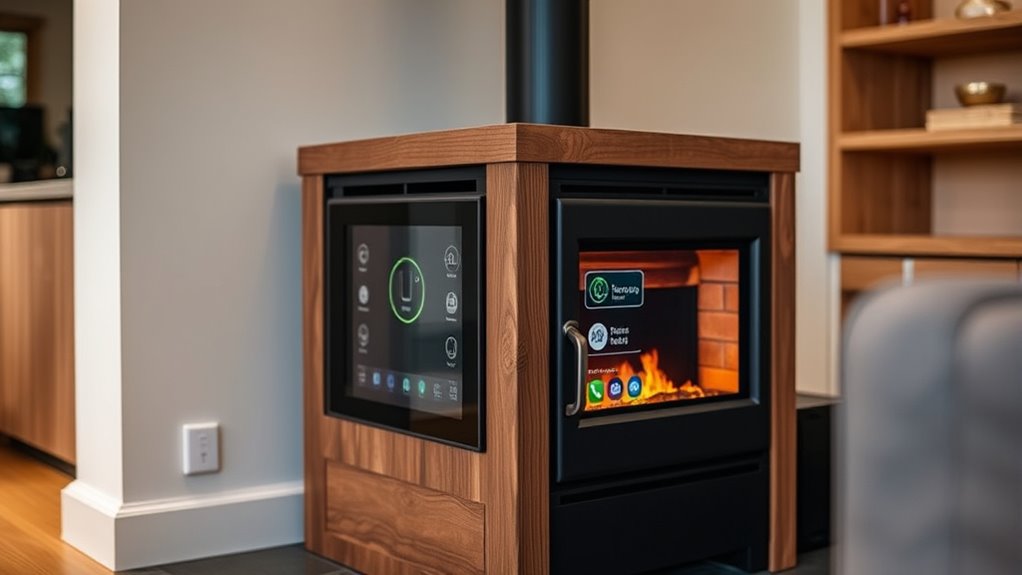
Automating damper and air intake controls relies on sensors and actuators that respond to real-time stove temperature data to enhance airflow. This system ensures efficient combustion, reduces fuel use, and minimizes emissions. Using a PID control algorithm, the damper adjusts precisely to maintain your desired temperature range. Integration with smart platforms like Home Assistant allows you to monitor and override controls remotely, adding convenience and safety. Typical setups involve thermocouples or flue sensors that trigger damper movements when temperatures deviate from preset thresholds. To keep your system running smoothly, regular calibration and self-check routines are essential. This prevents overheating and ensures your damper movements remain accurate, maximizing efficiency and safety.
- Sensors monitor real-time stove temperature data.
- Actuators adjust the damper based on control signals.
- PID algorithms fine-tune damper positions for optimal combustion.
- Smart integrations enable remote control and monitoring.
Ensuring Safety With Real-Time Notifications
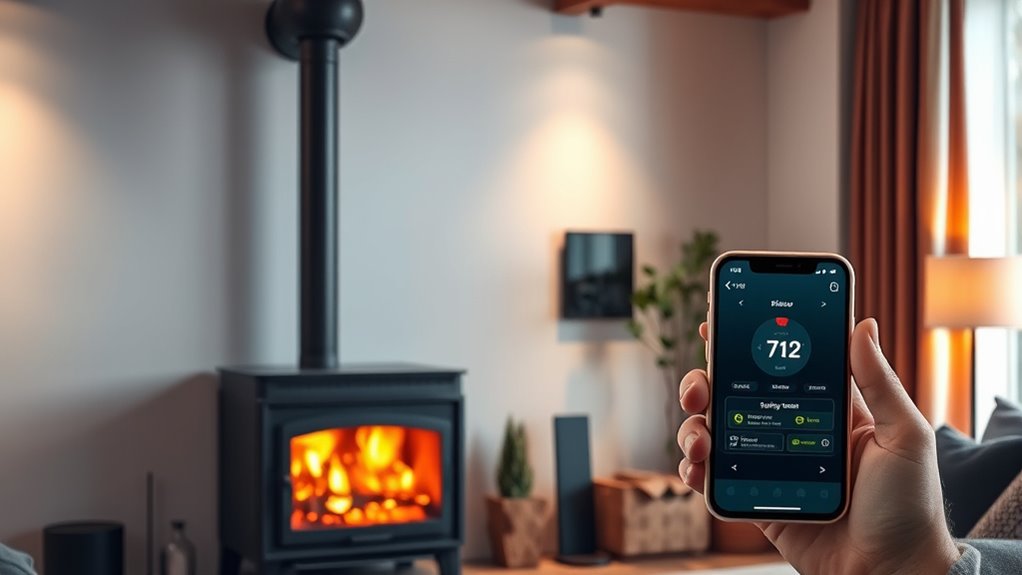
Building on automated damper controls, real-time notifications serve as an essential safety layer by alerting you instantly to any temperature irregularities or system issues. Sensors monitor key data like flue temperature and stove activity, sending alerts if temperatures rise too high or if the stove hasn’t been lit within a set time. This immediate feedback helps you respond quickly to potential hazards, such as overheating or system failure. Automated alerts can also notify you if the stove’s temperature drops below safe levels, preventing unsafe off-gassing or shutdowns. By integrating sensor data with your smart home platform, you receive customized notifications regardless of your location. These real-time alerts ensure you stay informed, enabling prompt responses that maintain safe, reliable operation of your wood stove.
Tips for Optimizing Burn Efficiency and Duration
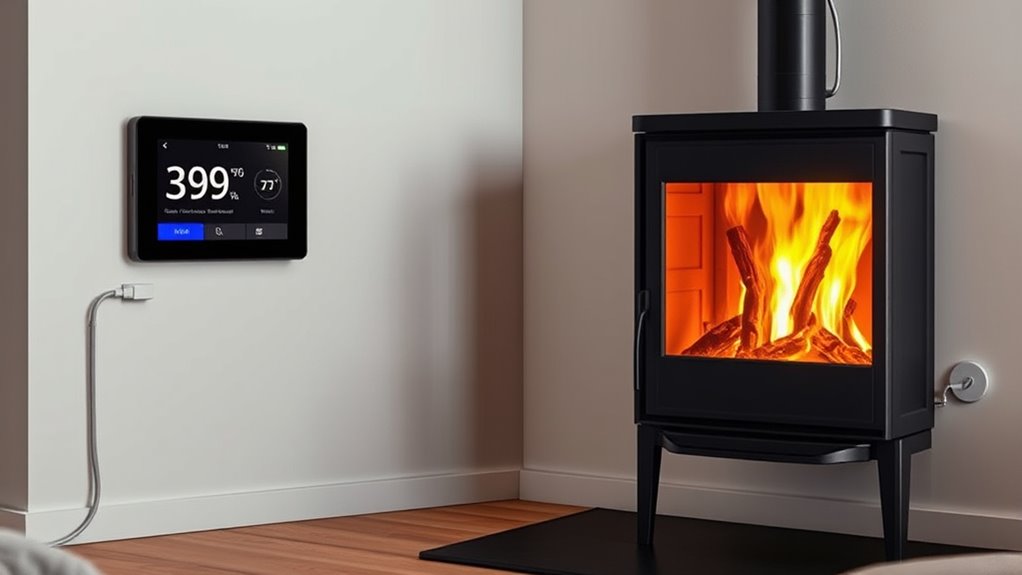
To maximize burn efficiency and extend your stove’s operating time, monitoring flue and stove top temperatures is essential. By keeping flue temps around 600°F and stove top temps below 650°F, you ensure effective combustion and minimize emissions. Real-time temperature data helps you adjust air intake and dampers precisely, preventing off-gassing and overheating. Using thermocouple sensors connected to a Raspberry Pi or ESP32 allows quick responses to temperature changes, enhancing fuel use. Logging these temperatures over time reveals the best refill points, especially when stove temps drop below 300°F. This proactive approach maintains a steady, efficient burn and prolongs fuel duration.
- Monitor flue temps (~600°F) regularly.
- Adjust air intake based on temperature readings.
- Use sensors for rapid response to fluctuations.
- Log data to identify ideal refill times.
Expanding Your System With Remote Access and Voice Commands
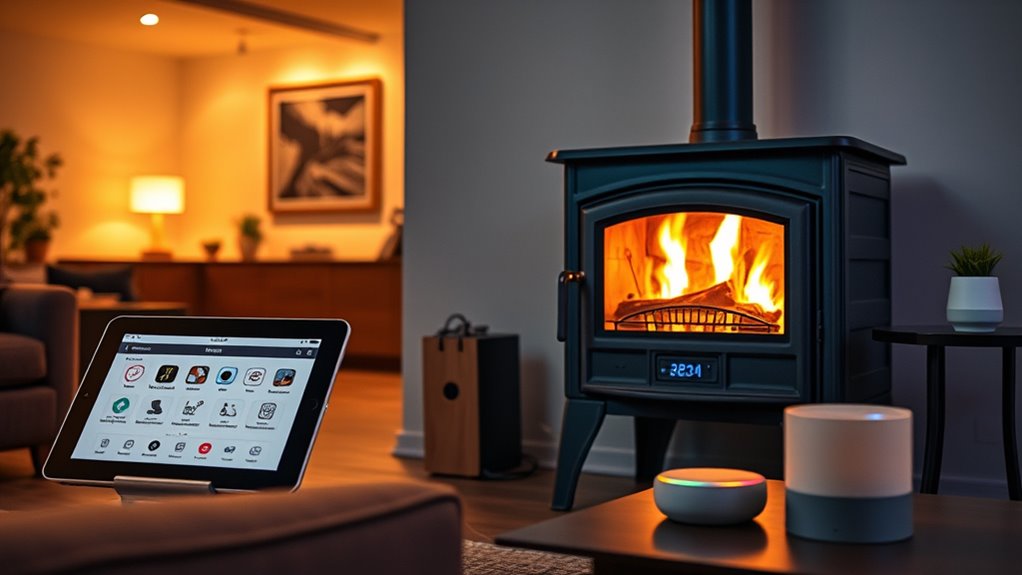
Enhancing your wood stove system with remote access and voice commands allows for convenient, real-time control and monitoring from anywhere. By integrating platforms like Home Assistant or openHAB, you can manage your stove via smartphone or web dashboards, ensuring comfort and safety. Linking voice assistants such as Alexa or Google Assistant lets you issue commands like “turn on the stove” or “adjust damper,” making operation hands-free. Implementing MQTT or REST API endpoints enables your devices to send status updates and execute commands remotely. You can also set up automation scripts that respond to temperature thresholds, triggering adjustments or safety alerts from afar. Additionally, customizing routines with voice commands allows seamless control over your stove’s operation, temperature, and alerts, enhancing both convenience and safety in your smart home setup.
Frequently Asked Questions
What Is the 3:2-10 Rule for Wood Stoves?
The 3:2-10 rule helps you maintain safe, efficient wood stove operation. It suggests keeping your stove top temperature around 300°F, and the flue or stovepipe should be about 10% hotter. This means for every 3 units of stove top heat, the flue should be about 2 units. Following this guideline helps prevent creosote buildup, improves combustion, and reduces chimney fire risks.
Is It Cheaper to Heat Your Home With a Wood-Burning Stove?
Imagine your home wrapped in a warm, glowing embrace—that’s the power of a wood stove. You might find it cheaper to heat your home this way, especially if you have access to inexpensive, local firewood. While the initial investment can be high, ongoing costs often drop markedly, making wood heating a budget-friendly choice. Just remember, costs depend on wood availability, stove efficiency, and local energy prices.
Can You Add a Wood-Burning Stove to a Mobile Home?
Yes, you can add a wood-burning stove to a mobile home, but you need to follow safety guidelines. Make sure to check local building codes, guarantee proper clearance, ventilation, and use a sealed combustion system. You might need to modify existing venting or ductwork. Always consult professionals and get necessary permits to ensure your installation is safe, legal, and efficient for your mobile home.
Why Is It Not Advisable to Use a Wood Stove?
You shouldn’t use a wood stove without proper safety measures because it can pose serious health and fire risks. Harmful pollutants like carbon monoxide and particulate matter can build up indoors if ventilation isn’t adequate. Without precise temperature control, you might overheat your home or cause a fire. Burning wet wood increases smoke and creosote, risking chimney fires. Overall, safety and health are compromised without proper installation, maintenance, and monitoring.
Conclusion
By integrating your wood stove into your smart home, you’re not just controlling heat—you’re nurturing a dependable guardian that keeps your home warm and safe. Think of it as a steady flame guiding you through chilly nights, always watching, always ready. With these smart touches, your stove becomes more than just a source of warmth; it’s a symbol of comfort and security, illuminating your home’s heart with innovation and care.

